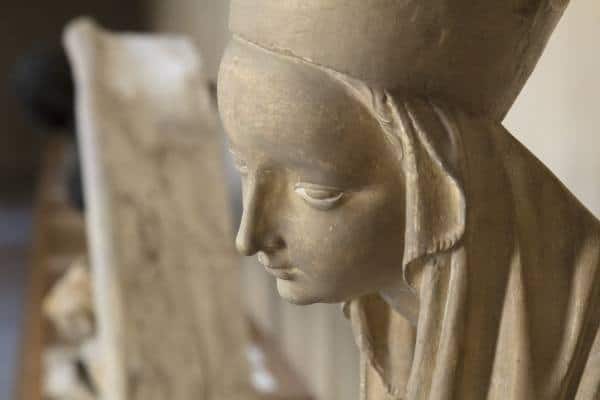Introduction about haptic exposure
The National Gallery Prague owns a large collection of casts of medieval works. More than a dozen works have been selected from them, illustrating the stylistic transformation of sculptural form from the Romanesque period to the late Gothic. The selection clearly shows how the approach of sculptors to the representation of religious images and everyday reality changed over the centuries. The collection on display depicts stone sculptures and carvings in copies. The originals of some of these sculptures remain centuries later in the places for which they were created. This is the case, for example, with the portrait busts from Prague's St. Vitus Cathedral or the beautiful Plzeň Madonna. Others can be seen today in the gallery exhibition.
Introduction to Gothic sculpture
The Gothic style has its roots in France and came to us indirectly, especially via the Rhineland in the mid-13th century. Medieval sculpture was closely intertwined with architecture in the early period. Statues were placed outside and inside. Often they decorated portals and anterooms, and indoors they were on consoles, columns and pillars, complementing the decoration of altars. Later on, statues were increasingly used outside architecture, which is related to the change in their format and the variety of materials used. In addition to stone sculptures, usually made of limestone or sandstone, many wood carvings have survived. In the Czech lands, the wood most often used was that of lime, and more rarely of fruit trees and conifers. Wood carvings, but also some stone sculptures, were usually given a colour treatment - polychromy.
Votive relief from the Basilica of St. George
Bohemia, before 1228
Casting: patinated plaster
Original: golden haze, remnants of original polychrome, central part h. 88 cm, w. 57 cm, wings h. 66 cm, w. 27 cm
The relief consists of three parts, most probably secondarily connected into one whole. The middle panel is filled with the most important figure of the Virgin Mary seated on a throne. She is holding the Infant Jesus on her lap, depicted in profile, with her right hand raised in blessing. In the two upper corners, angels with censers float on clouds. They place a crown on Mary's head, which, like the angels, is surrounded by a halo. An engraved Latin inscription on the frame identifies the tiny figures kneeling beneath the steps of the throne at Mary's feet. On the left, with clasped hands, is Princess Mlada, sister of Prince Boleslaus II. She was abbess of the first female Benedictine monastery of St. George at Prague Castle, founded by her brother in 973. On the opposite side is a depiction of Abbess Berta praying. On the right wing kneels King Přemysl Otakar I, as it appears from the preserved inscription on the edge of the frame, and on the opposite wing a praying nun, probably Abbess Agnes, the king's half-sister.
Madonna from Prostějov
Master of the Michel Madonna - workshop
Prague (?), around 1340
Casting: patinated plaster, head of the Madonna h. 32 cm
Original: lime wood, remnants of original polychrome,
h. 113,5 cm
The sculpture is attributed to the workshop of an excellent carver working in Prague or Brno in the second quarter of the 14th century. According to one of his most famous works, he is helpfully called the Master of the Michel Madonna. The Madonna of Michle is on display in the long-term exhibition of medieval art here. The head of the Prostějov Madonna on display is part of a carving of the Virgin Mary standing with the Baby Jesus. Mary is without a crown, the veil at the back covers her hair and does not fall freely on her shoulders, but envelops her whole chest. The detailed fine carving on the top of the tousled strands of wavy hair is striking. They are twisted into deep folds that frame the face. A hint of a smile animates the face with wide open eyes, a short, gently upturned nose and a small chin.
Franciscan Madonna
Prague (?), after 1350
Casting: epoxy resin, polychrome
Original: lime wood, later polychrome, h. 134 cm
The statue decorated the cloister of the Franciscan monastery in Pilsen. The figure of the Virgin Mary is tall, elongated, slightly bent and slightly forward. On her right hand sits an unnaturally high child, whose head is almost level with Mary's. The baby Jesus is unclothed and his hips are covered by a veil. He is depicted almost in profile and both of his hands are pointing towards Mary's left forearm. The symbol of the sovereign power of the future unlimited ruler is the sphere which the Saviour holds in his left hand. The child's lively hand gesture breaks the deep contemplation and a certain rigidity. Mary's face is framed by intricately braided strands of long hair, and her uncrowned head is covered by a veil. The lower straight dress is covered by a cloak fastened at the chest with a clasp. The right end of the cloak, draped over the arm, creates several sharply cut folds that disrupt the otherwise flowing rhythm of the garment.

Petr Parler
Svatovítská hut, 1378 - 1379
Casting: epoxy resin, patinated
Original: sandstone, 63 x 60 cm
The esteem in which the architect of St.Vitus Cathedral was held is evidenced by the inclusion of his likeness in the portrait gallery of members of the royal family on the triforium of St.Vitus Cathedral. The triforium is a cathedral-style gallery in the thickness of the church wall, open to the interior and located under the windows and above the arcades in the choir and nave. As evidenced by the inscription above the bust in the triforium, Charles IV summoned the twenty-three-year-old Peter Parléř to Prague and appointed him in 1356 as the builder of St. Vitus Cathedral. In the likeness he has an oval face with slightly sunken cheeks, a high arched forehead and sparse, short-cropped hair combed behind his ears. The gaze of the eyes, without emphasizing the eyelids, suggests deep thought. The moustache beneath the narrow regular nose is followed by a short beard on a nondescript chin. The folded edge of the collar creates a natural bowl-shaped fold under the neck. On the chest is a well-preserved masterful emblem: a stone charcoal shield.
Charles IV.
Svatovítská hut, 1375 - 1378
Casting: epoxy resin, patinated
Original: sandstone, 58 x 59 cm
Charles IV was often depicted in the 4th century. His image can be found in wall, panel and book paintings, in mosaics, in goldsmithing, on seals and coins. The portrait of Charles IV from the triforium of the St. Vitus Cathedral was, like other portrait busts, created life-size, polychromed and accompanied by an emblem. The likenesses of the members of the royal family are arranged in a strict hierarchy. In the most honourable place in the middle is the bust of Charles IV. The king has large, far apart eyes. The upper eyelid is emphasised by two strong lines, the lower one is almost straight. The slightly open mouth under the strong short nose is framed by a sculpted moustache and beard. The hair is covered at the sides by long wide ribbons ending in fringes. They cover the raised edge of the collar. It is a remnant of the mitre, a liturgical headdress.
Anna Svidnicka
Svatovítská hut, 1375 - 1378
Casting: patinated plaster
Original: sandstone, 55 x 53 cm
The 14-year-old daughter of Duke Henry of Svídnice, Princess Anne, became the third wife of the then thirty-seven-year-old Charles IV on 27 May 1353. Two months later she was crowned Queen of Bohemia in Prague and Queen of Rome on 9 February 1354 in Aachen. The likeness of Anna Svídnická is one of the most charming busts of the triforium. The oval face on a slender neck with a high, broad forehead is framed by long natural strands of hair that fall loosely over the shoulders. The gentle smile, the joyful eyes, the small narrow nose and the small chin recall the loveliness of the Madonnas of the emerging beautiful style. Anna Svidnicka's life came to an early end. She died a year after the birth of her son Wenceslas (born 26 February 1361), the heir to the throne, eagerly awaited by all.
Console with dog and cat
Svatovítská hut, 1370 - 1380
Casting: patinated plaster
Original: sandstone, 42 x 73 cm
Gothic architecture was complemented by fanciful animal and grotesque motifs. On the outer triforium of St. Vitus Cathedral there are small reliefs of animals under the consoles: a lioness with cubs, a bear, a horse, a unicorn, an eagle, a cat, a hen's head, and on the inner triforium a male mask and a wrestling cat and dog. The representation of a cat is associated with both positive and negative meanings in the Middle Ages. The dog is an image of loyalty, but also of envy and anger. A relief from St. Vitus Cathedral shows a cat on the left being threatened from the right by an attacking dog with its teeth bared. It is bent in an arch. Her right front leg is offended and her left leg rests on the dog's head in defence. Her hind legs are against the body of her attacker. The relief of the cat and dog, reproduced on the following page, is an example of a work in which the sculptor showed his sense of capturing the reality of ordinary life.
The fight of St. George with the dragon
Martin and George of Cluj, 1373
(active in the last third of the 14th century)
Casting: patinated plaster, h. 50 cm
Original: lead bronze, h. 196 cm, w. 177 cm
The exhibited torso of the figure of St. George, cast in plaster, is from a bronze equestrian sculpture of St. George fighting a dragon. In the 16th century, the original statue was placed on the fountain in front of the St. George's Monastery and from the 18th century on the third courtyard of Prague Castle, where a copy of the statue can be found today. The plaster cast represents only the upper part of the figure of the warrior. St. George is completely missing his right arm, the left one ends in an elbow. He is dressed in the armour of a medieval knight, his narrow waist is encircled by a belt with a buckle on which a sword was attached. His face is young, almost smilingly dreamy, with only the wrinkles on his forehead joined in a kind of ring. The eyes are irregularly shaped with slightly drooping upper lids. The cult of St George was very popular in the Middle Ages. According to legend, this famous knight was born in Asia Minor at the end of the 3rd century and was martyred during the reign of Emperor Diocletian.
Lactating Madonna from Konopiště
Prague, around 1370
Casting: patinated plaster
Original: walnut wood, later polychrome, h. 50,5 cm
The motif of the Virgin Mary nursing the baby Jesus had a symbolic meaning in the Middle Ages. However, it also faithfully depicted the image of maternal love. The Madonna is seated on a cushion, slightly curved, the raised hem of her dress revealing the tip of her left foot. With her left hand she lovingly clasps the child to her, with her right hand she holds the breast from which the baby Jesus eagerly drinks, and with her folded leg she lightly rests on her mother's lap. Our Lady's head is uncrowned and slightly tilted to the right. The face is framed by long wavy curls of hair. Her eyes are thoughtful, as if anticipating the sad fate of her child. A wide veil covers the top of her head and falls loosely over both shoulders. The longer left end of the veil envelops the child's body, while the shorter right end forms a graceful curve on the chest. The religious theme is transformed into a representation of the emotional relationship between mother and child. Like the original walnut wood carving, the cast has minor damage. Mary's nose, part of the veil and one side of the cushion have been insulted.
Tympanum of the northern portal of the Church of Our Lady before Týn
Prague, around 1380
Casting: patinated plaster, detail of the upper right side segment of the Wrestling of Devils with an Angel for the Soul of the Evil Scoundrel, h. 95 cm, w. 137 cm
Original: opuka, high relief, whole h. 232 cm, w. 302,5 cm
The tympanum from the Church of the Virgin Mary before Týn in Prague is an important monument from the reign of Wenceslas IV. It consists of five relief panels with Passion scenes. The exhibited fragment of the Struggle of the Devil for the Soul of the Evil Scoundrel is only a small part of it. The devils seize the soul of a hardened robber. Three monsters with fierce animal heads and repulsive grins surround the figure struggling in mortal combat. The fiend on the right firmly grips the unfortunate man's left arm and leg, while the other grasps his right hand and backwards twisted head. The third firmly holds the sole of the villain's right foot. The wrestling scene is the dramatic climax of the tympanum decoration. Thoughtful movement dominates the entire composition. Originally, this relief was also polychromed.
Madonna of Pilsen
Prague, 1384 (shortly before 1384)
Casting: patinated plaster
Original: opuka, original polychrome, h. 125 cm
One of the most famous venerated Marian statues from the beautiful style period was created in Prague for the main altar of the Church of St. Bartholomew in Pilsen. The Virgin Mary stands on a low plinth, holding the naked baby Jesus diagonally in front of her. The fingers of the left hand rest naturally on the child's body. The figure of the Madonna is in motion, askew, the weight of the body resting on the left leg, while the free right leg is significantly bent. Slightly tilted towards the shoulder, the uncrowned head turns towards the baby Jesus with a sweet smile and as if dreamy eyes. The child turns away from his mother and his gaze is directed towards the viewer. The apple he holds with both hands is the fruit of the tree of the knowledge of good and evil, pointing to Jesus as the future Redeemer of mankind from original sin. Our Lady's cloak, covering her lower garment, is slightly open and fastened with a clasp. The edge of the cloak, draped over the right arm, forms a rich cascading frill that falls freely in tubular folds.
Christ the Sufferer on the clouds
Bohemia, after 1475
Casting: patinated plaster
Original: lime wood, later polychrome, h. 72 cm
The face of the Son of God is full of suffering. On His head is a crown of thorns, which has been partially damaged. The bulging upper eyelids give a melancholy expression to the downward gaze. Also, the depression between the protruding arches of the eyebrows and the drooping corners of the mouth enhance Christ's pain. The hair, modelled in neat waves, flows loosely over the shoulders. The right strand is damaged. With the thumb of his right hand, Jesus points to the open wound, raising his left in a gesture of prayer and intercession. The semi-figure is set in a stylized band of clouds, for Christ will return on clouds at his second coming to earth. Jesus shows his wounds to God the Father to assuage his wrath over corrupt humanity, while acting as Savior and future judge of the sins of the living and the dead.
ngprague.cz/gnews.cz-jav



